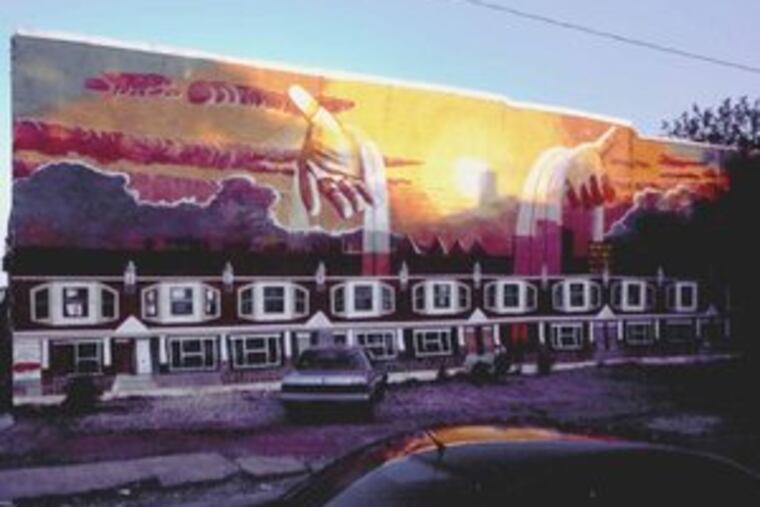Obituary: Ras Malik, prominent Phila. muralist
Ras Malik, 72, one of Philadelphia's most prominent mural artists whose creations were a ballast against urban blight and a reflection of the people of the neighborhoods, died of cancer July 31 at Care Pavilion of Walnut Park. He lived in Norris Square.

Ras Malik, 72, one of Philadelphia's most prominent mural artists whose creations were a ballast against urban blight and a reflection of the people of the neighborhoods, died of cancer July 31 at Care Pavilion of Walnut Park. He lived in Norris Square.
"Ras Malik was the definition of a superb muralist," said Jane Golden, director of Philadelphia's Mural Arts Program. "He was more than a painter. I was moved by his kindness. He was a gentle person who could capture the spirit of a neighborhood. He gave the city a lasting legacy, not only in his murals, but to the young artists he touched."
Mr. Malik, who was born Henry Harris, made art since childhood in Henderson, S.C., where he attended a one-room schoolhouse until dropping out at 13. His father died when he was 7 and he worked as a sharecropper with his mother and four siblings in the tobacco fields.
At 18, Mr. Malik moved to North Philadelphia, where he worked various jobs, studied commercial art, and earned a general equivalency diploma before being drafted into the Army in 1957.
Mr. Malik was a medic stationed in Korea, Germany and Houston, where his artistic talent was noticed by his Army superiors and he was trained in anatomical illustration at a medical facility in Houston.
After being discharged in 1961, he worked at the former Holmesburg Prison as a corrections officer until 1974. While working at the prison, he earned a bachelor's degree in illustration at the University of the Arts on the GI Bill.
Mr. Malik said the prison was a hard place to work. "I can still smell the most horrendous odor in the jails. I can still hear that profanity," he said in an interview for the 2002 book Philadelphia Murals and the Stories They Tell, by Jane Golden, Robin Rice and Monica Yant Kinney (Temple University Press).
Again, his talent was recognized by his bosses, this time the prison warden who asked him to teach art classes to inmates for rehabilitation.
In the mid-1970s, Mr. Malik formed the Bastille Art League in Philadelphia with some former students who were no longer incarcerated.
Mr. Malik was a book illustrator and had a sign-painting business until he met Golden in the late 1980s.
She immediately hired him to teach in the Philadelphia Anti-Graffiti Network.
In 1994, Mr. Malik painted his first mural. Artist William Freeman needed help painting sports figures on the columns beneath an overpass at Ridge Avenue and Ferry Road in East Falls.
When the Mural Arts Program was founded in 1996, Mr. Malik was given solo commissions to paint murals every year. He continued until he became too ill, about a year ago.
After painting his second mural, a landscape and waterfall, Forest Green, at Emerald and Dauphin Streets in mostly Latino Norris Square, Mr. Malik moved to the neighborhood. He joined the board of the Norris Square Civic Association and taught art to children after school.
During this time he took the African name Ras Malik, which means "loyal tribal leader," said his daughter Denise Henderson.
Mr. Malik, who was a student of yoga and Buddhism, painted Compassion at 55th and Regent Streets in 1997, a painting of hands coming down from the sky pouring blessings on the neighborhood.
People began to clean up trash and plant flowers in the shadow of the mural.
"It's a great feeling to do something that changes a neighborhood," he said.
In addition to his daughter, Mr. Malik is survived by a daughter, Michele Harris; a son, Wayne Harris; three grandchildren; two brothers; and a sister. His former wife, Loretta Harris, also survives.
A celebration of life with African dancers, drummers and a choir will be at 5 p.m. tomorrow at SGI-USA Philadelphia Community Center, 2000 Hamilton St., Suite 210, Philadelphia. Burial was private.
Donations may be made to the American Cancer Society, 1626 Locust St., Philadelphia 19103.
More Information
To see Mr. Malik's work for the Mural Arts Program, go to http://cml.upenn.edu/murals/mbQueryAction.asp.
EndText